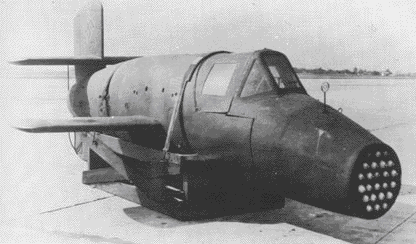Bachem Ba 349 Natter
Germany | Arado Ar 68 | Arado Ar 234 | Bachem Ba 349 | BV40 | BV 155 | Dornier Do 335 | Fw 187 Falke | Fw 189 Uhu | Fw 190 | Fw Ta 152 | Fw Ta 154 | Heinkel He 51 | Heinkel 100 | Heinkel 112 | Heinkel 113 | Heinkel 162 | Heinkel 219 | Heinkel 280 | Henschel 123 | Junkers Ju88 | Junkers Ju388 | Bf 109 | Bf 110 | Me 210 | Me 410 | Me 163 Komet | Me 262 | Me 263 | Me 328
Bachem Ba 349
In Germany, in late 1943 to early 1944, high altitude bombing from the Americans and British was gradually destroying the industrial might of the Third Reich, and unless something was done to stop the bombing, the entire ability of Germant to wage war would be cut off. Already short of critical materiel such as steel, oil, and machinery, the Bachem Werk company under took to build a bomber destroyer that used only a very limited amount of scarce items. Apart from the fuel tanks and wing mainspar, everything used to build the Natter (Adder) was non-essential products, most of this being wood. In fact, the entire fuselage, tail, and wings were wooden, and the only steel used was for the pilot armor and fuel tanks.
The Natter was rocket propelled, using two highly volatile fuels that would "explode if you looked at it crosseyed." This fuel was the infamous mixture of T-stoff and C-stoff, so incredibly explosive that the two would combust if they even made contact with the other. At first, the only tests given to the nine prototypes were gliding tests, being released from an He111 bomber at 18,000 feet. Surprisingly, the Natter had splendid stability, despite the shortness of the wings. A pilotless launching with the rocket engine as propulsion was completed successfully on Dec. 22, 1944, and in Feb. 1945, the first pilot took the Natter up for a flight. The test pilot did not survive.
This did not slow the development, and more inexperienced pilots were strapped into the Ba 349 and launched off into the sky, the lucky ones managing to survive the launch. Even more dangerous was the method of 'landing.' The Natter was not be be landed, rather the pilot would eject from the cockpit from either an ejection seat, or more often, a simple parachute. Then the rocket half of the machine would break off from the nose and it too would parachute down for reuse.
Perhaps even more frightening was the armament of this bizarre craft. Twenty four 55-mm unguided rockets were mounted in the nose of the Natter and were to be fired into a group of bombers. Although one hit from one of these rockets would probably bring down the bomber, just launching them from the Natter would be dangerous enough. A simple ring sight was mounted on the nose of the Ba 349 for aiming. Clearly it can be seen that these rockets were not supposed to be accurate.
In April of 1945 nine of the 36 Natters that had then been completed were set up to await the next wave of Allied bombers, but US ground troops suddenly attacked and the Germans themselves destroyed the Natters to keep them from falling into Allied hands. The Natter subsequently never saw action.
Specifications for Ba 349A:
Type: Single seat bomber destroyer, rocket powered
Engine: One 4,400lb/thrust HWK 109-509C rocket engine
Takeoff Boost: Four 1,100lb/thrust Schmidding boosters, with one minute endurance
Armament: 24 56-mm R4M unguided air-to-air rockets
Performance: Maximum speed 622mph; endurance on main rocket 2.3 minutes.
Weights: 4,800lbs loaded. No other data available.
Deminsions: Span 13 ft 1in; length 21ft 3in; wing area 51.6 sq/feet.
